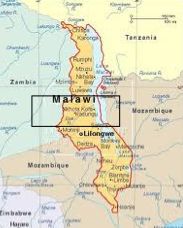Mchenga School Completed April 4, 2011!
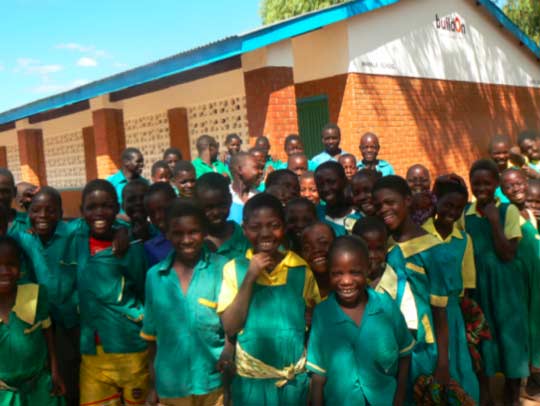
Schoolchildren excited about their new school!
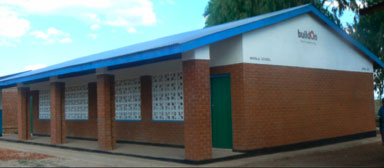
Mchenga Community Profile
Mchenga is part of Kasungu district, in the central region of Malawi, and was founded in 1965 by the families of Chipazayani Salangwa and Aliyazeli Thimbwidza. The current population of Mchenga is 2,857 people who belong to 423 different families. Most of these people are part of the Chewa ethnic group and most are also Christian, though there are some Muslims in the community as well. Mchenga is 43 km from the buildOn office in Kasungu and 162 km from the capital, Lilongwe. The community leader of this area is Traditional Authority Chilowamatambe; under him is sub Traditonal Authority Chambwe, followed by Senior Group Village Headman Chinguwo and finally the Village Headman Mchenga.
The primary income generating activities of the people in Mchenga are agriculture and small livestock keeping. Families practice subsistence farming, passing down their land from one generation to the next. The main crops grown in Mchenga are tobacco, cassava, groundnuts (peanuts), bambara nuts and potatoes. Some families also fish in the nearby Vyeyo and Chikasa Rivers. The climate is tropical, with a rainy and a dry season each year- the last droughts were in 2002 and 2005. All 2,857 residents of Mchenga share just 3 boreholes, deep wells that provide clean water year round. The closest medical clinic to Mchenga is 23 km away and the nearest hospital is in Kasungu, so to seek medical care people from Mchenga must make a long journey on foot or by oxcart if they cannot hitch a ride.
The primary income generating activities of the people in Mchenga are agriculture and small livestock keeping. Families practice subsistence farming, passing down their land from one generation to the next. The main crops grown in Mchenga are tobacco, cassava, groundnuts (peanuts), bambara nuts and potatoes. Some families also fish in the nearby Vyeyo and Chikasa Rivers. The climate is tropical, with a rainy and a dry season each year- the last droughts were in 2002 and 2005. All 2,857 residents of Mchenga share just 3 boreholes, deep wells that provide clean water year round. The closest medical clinic to Mchenga is 23 km away and the nearest hospital is in Kasungu, so to seek medical care people from Mchenga must make a long journey on foot or by oxcart if they cannot hitch a ride.
Mchenga Community Comments
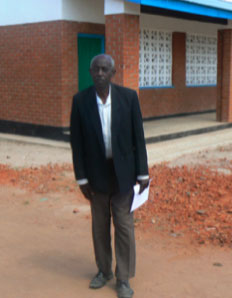
Interview with Peter Kaganga, age 72
“Illiteracy left me on the disadvantaged side. I was brought up in a very poor family that practiced subsistence farming with very limited financial resources, and education was laughter. I was learning at Chilowa School, 10 km away from my home. I used to walk to school and arrive tired, hit by bad weather, poverty stricken. I was not even following the class work due to hunger and low concentration. Many of my fellow students dropped out. They joined their parents in farming but life was even worse for them. Many got married but this did not help at all.
As an adult I decided to mobilize the entire community to request a government school to be established close to my village- so that my children do not face the same challenges I faced. We erected temporary shelters and the government considered the request. buildOn supported us with the 1st block and I was elected as a member of the project leadership committee because they wanted people who are literate. I encouraged my people to enroll in the community education program, which transformed many people who became literate. They now are able to help their own children to solve whatever they learned at school.
My main goal is to improve the academic lives of my children and the entire community for a bigger social change. Now I am very proud because my dream of building a school nearby where my children could learn has come true and one of my daughters is a teacher at this school. I am very thankful to buildOn for the two blocks constructed and launch of the community education program that benefited so many households.”
Education is a key to the development of a community; if more of our children get a good education they will be knowledgeable about socio- economic issues and this will lead to development in this area.
Numero Chinwe, parent, 47 years old
The school is a more attractive environment to teach in and even pupils from the neighboring villages have joined us. There will be no question of class interruptions due to bad weather, absenteeism will be reduced and it’s my hope that even the students who have dropped out will come back.
JB Msolopa, age 39, 7th grade teacher working in Mchenga for 11 years
Volunteer work and good leadership proved to be the only tools to develop our area and address the shortcomings of our children’s academic lives. buildOn could not have supported us if we remained idle in changing our own community and I have liked the methodology very much.
Mr. Omuzile Chinguwo, age 29, now literate after graduating from the Community Education Program
Prior School Conditions
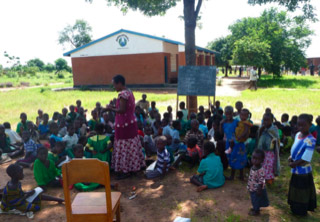
Mayala Primary School
Formal education has only been available in Mchenga since 1998, and there is currently just one permanent, brick school block there (built by the community with buildOn support in 2007). These 2 classrooms make up Mayala Primary School, where 780 students (340 boys and 440 girls) from the surrounding villages of Mchenga attend classes. Just 5 teachers instruct all 780 of these students in grades 1-8. Since there isn’t room for all of them inside the buildOn school, many students study outdoors or in temporary shelters. During the rainy season and the hottest part of the dry season, many students drop out of school because of these conditions. In order to continue past primary school, students must walk 4 km to Kadifula Secondary School.
The Mayala School Project - Second School Block Construction
The second buildOn school block of the Mayala school will have two classrooms and be constructed out of more than 50,000 clay bricks molded by the villagers and fired in a kiln over the past several months. The finished school will have a corrugated tin roof and a poured concrete floor and will be completed in early May 2011.

Mayala students dance for US trekkers
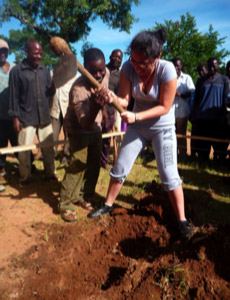
A trek member digs the foundation
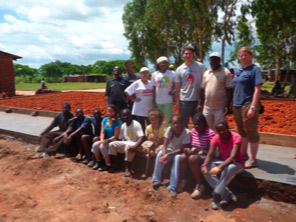
The trek team and Malawi staff
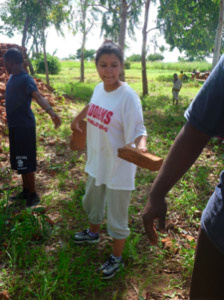
NY and Mali Students working
This project broke ground on February 16th, 2011 with the help of a Trek for Knowledge team of 11 high school students from buildOn’s after-school program in NY. These students were chosen from 8 different high schools and earned the opportunity to participate in the Trek after doing extensive local community service. They lived with host families, participated in a cultural exchange, and worked side by side with community members for 10 days on the worksite. Per buildOn methodology, they participated in the covenant signing ceremony with the community of Mchenga and buildOn staff before breaking ground on the new school. This covenant outlines the plan for the project and the following duties:
Community Contribution
• Unskilled labor: 30 workers (15 men and 15 women) per day, six days per week
• The land on which the school is built
• High quality local materials: sand, gravel, water & rocks
• Project management: a committee made up of 12 villagers (six men, six women)
• Lodging for buildOn team: Field Coordinator and skilled laborers
• Basic construction tools (shovels, picks, wheelbarrows, buckets, etc.)
• Commitment to educating boys and girls equally
buildOn Contribution
• Construction materials (excluding local materials) for school and latrine
• Skilled labor and plans needed to build the school
• Project management (buildOn coordinators)
• Instruction in basic construction techniques
Community Contribution
• Unskilled labor: 30 workers (15 men and 15 women) per day, six days per week
• The land on which the school is built
• High quality local materials: sand, gravel, water & rocks
• Project management: a committee made up of 12 villagers (six men, six women)
• Lodging for buildOn team: Field Coordinator and skilled laborers
• Basic construction tools (shovels, picks, wheelbarrows, buckets, etc.)
• Commitment to educating boys and girls equally
buildOn Contribution
• Construction materials (excluding local materials) for school and latrine
• Skilled labor and plans needed to build the school
• Project management (buildOn coordinators)
• Instruction in basic construction techniques
